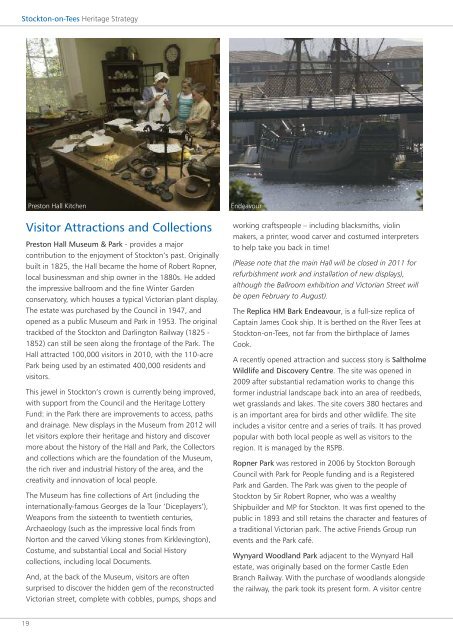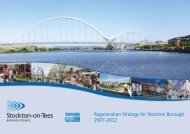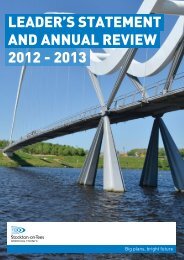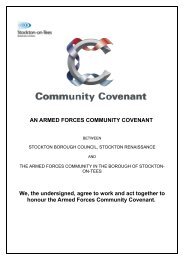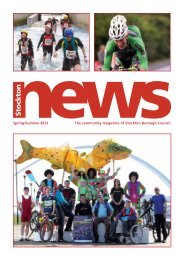Heritage Strategy - Stockton-on-Tees Borough Council
Heritage Strategy - Stockton-on-Tees Borough Council
Heritage Strategy - Stockton-on-Tees Borough Council
You also want an ePaper? Increase the reach of your titles
YUMPU automatically turns print PDFs into web optimized ePapers that Google loves.
stockt<strong>on</strong>-<strong>on</strong>-<strong>Tees</strong> <str<strong>on</strong>g>Heritage</str<strong>on</strong>g> <str<strong>on</strong>g>Strategy</str<strong>on</strong>g><br />
Prest<strong>on</strong> Hall Kitchen<br />
Visitor attracti<strong>on</strong>s and collecti<strong>on</strong>s<br />
Prest<strong>on</strong> hall Museum & Park - provides a major<br />
c<strong>on</strong>tributi<strong>on</strong> to the enjoyment of <str<strong>on</strong>g>Stockt<strong>on</strong></str<strong>on</strong>g>’s past. Originally<br />
built in 1825, the Hall became the home of Robert Ropner,<br />
local businessman and ship owner in the 1880s. He added<br />
the impressive ballroom and the fine Winter Garden<br />
c<strong>on</strong>servatory, which houses a typical Victorian plant display.<br />
The estate was purchased by the <strong>Council</strong> in 1947, and<br />
opened as a public Museum and Park in 1953. The original<br />
trackbed of the <str<strong>on</strong>g>Stockt<strong>on</strong></str<strong>on</strong>g> and Darlingt<strong>on</strong> Railway (1825 -<br />
1852) can still be seen al<strong>on</strong>g the fr<strong>on</strong>tage of the Park. The<br />
Hall attracted 100,000 visitors in 2010, with the 110-acre<br />
Park being used by an estimated 400,000 residents and<br />
visitors.<br />
This jewel in <str<strong>on</strong>g>Stockt<strong>on</strong></str<strong>on</strong>g>’s crown is currently being improved,<br />
with support from the <strong>Council</strong> and the <str<strong>on</strong>g>Heritage</str<strong>on</strong>g> Lottery<br />
Fund: in the Park there are improvements to access, paths<br />
and drainage. New displays in the Museum from 2012 will<br />
let visitors explore their heritage and history and discover<br />
more about the history of the Hall and Park, the Collectors<br />
and collecti<strong>on</strong>s which are the foundati<strong>on</strong> of the Museum,<br />
the rich river and industrial history of the area, and the<br />
creativity and innovati<strong>on</strong> of local people.<br />
The Museum has fine collecti<strong>on</strong>s of Art (including the<br />
internati<strong>on</strong>ally-famous Georges de la Tour ‘Diceplayers’),<br />
Weap<strong>on</strong>s from the sixteenth to twentieth centuries,<br />
Archaeology (such as the impressive local finds from<br />
Nort<strong>on</strong> and the carved Viking st<strong>on</strong>es from Kirklevingt<strong>on</strong>),<br />
Costume, and substantial Local and Social History<br />
collecti<strong>on</strong>s, including local Documents.<br />
And, at the back of the Museum, visitors are often<br />
surprised to discover the hidden gem of the rec<strong>on</strong>structed<br />
Victorian street, complete with cobbles, pumps, shops and<br />
Endeavour<br />
working craftspeople – including blacksmiths, violin<br />
makers, a printer, wood carver and costumed interpreters<br />
to help take you back in time!<br />
(Please note that the main Hall will be closed in 2011 for<br />
refurbishment work and installati<strong>on</strong> of new displays),<br />
although the Ballroom exhibiti<strong>on</strong> and Victorian Street will<br />
be open February to August).<br />
The replica hM bark endeavour, is a full-size replica of<br />
Captain James Cook ship. It is berthed <strong>on</strong> the River <strong>Tees</strong> at<br />
<str<strong>on</strong>g>Stockt<strong>on</strong></str<strong>on</strong>g>-<strong>on</strong>-<strong>Tees</strong>, not far from the birthplace of James<br />
Cook.<br />
A recently opened attracti<strong>on</strong> and success story is saltholme<br />
Wildlife and discovery centre. The site was opened in<br />
2009 after substantial reclamati<strong>on</strong> works to change this<br />
former industrial landscape back into an area of reedbeds,<br />
wet grasslands and lakes. The site covers 380 hectares and<br />
is an important area for birds and other wildlife. The site<br />
includes a visitor centre and a series of trails. It has proved<br />
popular with both local people as well as visitors to the<br />
regi<strong>on</strong>. It is managed by the RSPB.<br />
ropner Park was restored in 2006 by <str<strong>on</strong>g>Stockt<strong>on</strong></str<strong>on</strong>g> <strong>Borough</strong><br />
<strong>Council</strong> with Park for People funding and is a Registered<br />
Park and Garden. The Park was given to the people of<br />
<str<strong>on</strong>g>Stockt<strong>on</strong></str<strong>on</strong>g> by Sir Robert Ropner, who was a wealthy<br />
Shipbuilder and MP for <str<strong>on</strong>g>Stockt<strong>on</strong></str<strong>on</strong>g>. It was first opened to the<br />
public in 1893 and still retains the character and features of<br />
a traditi<strong>on</strong>al Victorian park. The active Friends Group run<br />
events and the Park café.<br />
Wynyard Woodland Park adjacent to the Wynyard Hall<br />
estate, was originally based <strong>on</strong> the former Castle Eden<br />
Branch Railway. With the purchase of woodlands al<strong>on</strong>gside<br />
the railway, the park took its present form. A visitor centre<br />
19


